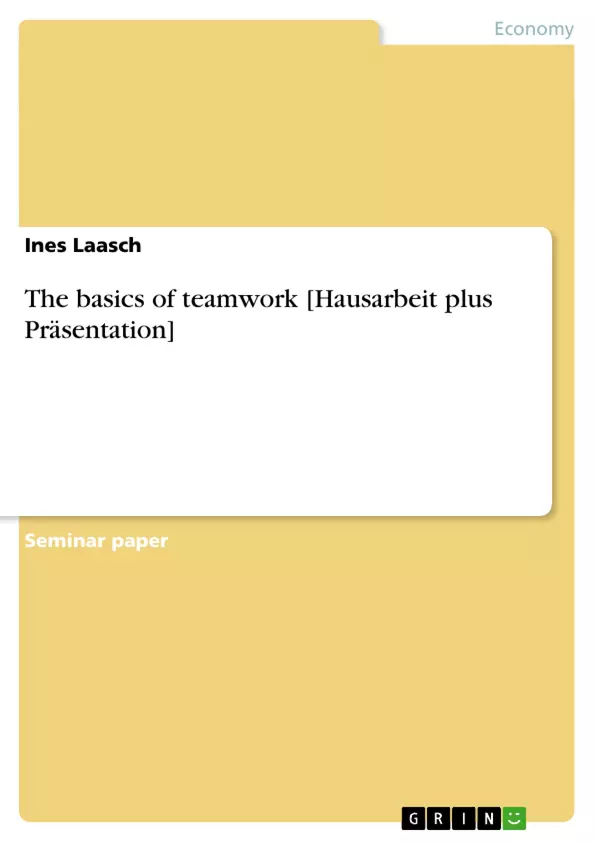At the moment teamwork is a very popular term. People say, that it is nowadays essential for being successful in business to be a teamworker, a teamplayer. But what exactly is a team and what makes teamwork special? Several books and the internet helped me to gather relevant information in order to answer this question.
Worldwide markets have changed enormously in the last two decades. Globalisation and liberalisation on the one hand and saturated markets on the other hand have led to high quality standards and customer orientation. In addition to that product life cycles have shortened, so that companies are under pressure to develop more new products and product variations in less time to reasonable costs. The need for more flexibilty and the necessity to adapt quickly to changing market conditions involved a reduction of layers in the management. One of the results is more responsibility for the employees. Not only that they become more and more involved in the decision making process, they also have to meet higher expectations as the tasks become increasingly more complex. It seems obvious that at a certain point one person alone can not handle difficult tasks any longer, especially if high financial and economic risks are associated. Therefore a rising number of companies forms teams.
This essay focuses on aspects a team leader has to consider if he or she gets the task to start a team from scratch. While the first chapter has given a short introduction, the second chapter defines teamwork and the steps on the way from a mere group towards a team. Then the third chapter examines conditions under which teams can prosper and perform outstandingly. After that the fifth chapter gives a short summary and allows an outlook. The last three chapters contain a list of vocabulary, references and a test, where you can find out what kind of teamplayer you are.
Inhaltsverzeichnis (Table of Contents)
- Introduction
- Building up a team
- Finding the right people
- The five stages of teamwork
- The first meetings
- Supporting a team
- Measuring performance
- Motivation and rewards
- Solving conflicts
- Conclusion
Zielsetzung und Themenschwerpunkte (Objectives and Key Themes)
This essay aims to provide a comprehensive overview of the principles and practices of effective teamwork, focusing specifically on the perspective of a team leader responsible for building a new team from scratch. The essay delves into the various aspects of team building, including selecting the right team members, fostering a conducive team environment, and ensuring successful team performance.
- Defining the nature and purpose of teamwork
- Identifying key elements for successful team building
- Exploring methods for selecting suitable team members
- Analyzing the role of team leadership in facilitating team effectiveness
- Examining strategies for maintaining team motivation and resolving conflicts
Zusammenfassung der Kapitel (Chapter Summaries)
The introductory chapter highlights the growing significance of teamwork in contemporary business environments, emphasizing the need for adaptability, flexibility, and quick decision-making in the face of dynamic market conditions. The chapter also introduces the essay's focus on the perspective of a team leader building a new team.
The second chapter dives into the concept of teamwork, defining it as a group of individuals with complementary skills committed to a common purpose, performance, goal, and approach. It emphasizes the importance of shared goals and a mutual commitment to success. This chapter also discusses the benefits of teamwork, including increased productivity, effectiveness, and synergy through collaboration.
The third chapter examines the crucial aspects of supporting a team to maximize its performance. It addresses the role of the team leader in providing guidance, support, and feedback, and explores various strategies for managing performance, motivation, and conflict resolution within the team.
Schlüsselwörter (Keywords)
The central focus of this essay lies on the principles of effective teamwork, encompassing aspects such as team building, team leadership, performance management, motivation, conflict resolution, and synergy. It emphasizes the importance of understanding the individual strengths and weaknesses of team members, fostering a cohesive and productive work environment, and ensuring the successful achievement of common goals.
- Arbeit zitieren
- Ines Laasch (Autor:in), 2002, The basics of teamwork [Hausarbeit plus Präsentation], München, GRIN Verlag, https://www.grin.com/document/12145

![Titel: The basics of teamwork [Hausarbeit plus Präsentation]](https://cdn.openpublishing.com/thumbnail/products/12145/large.webp)

